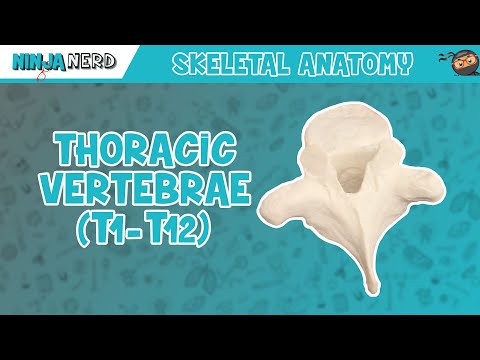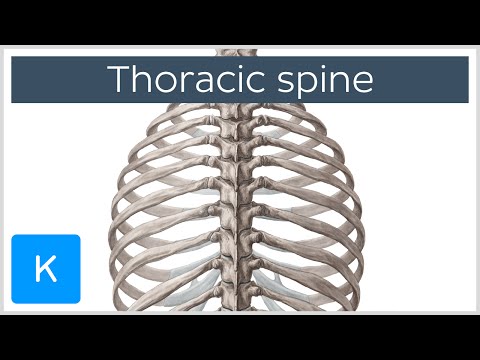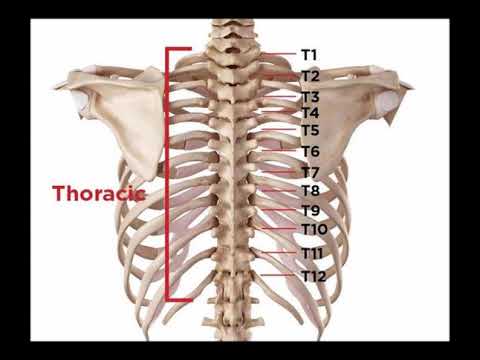When we talk about thoracic spine vertebrae, we’re diving into a key player in our body’s ability to move, perform, and thrive. The thoracic spine, made up of 12 individual bones, sits snugly in your upper and mid-back. It isn’t just there for show; it connects with your ribcage and lumbar spine, carving out a pathway for fluid movement and maintaining posture. Understanding the critical role of thoracic spine vertebrae is essential for athletes, fitness enthusiasts, or anyone striving for peak wellness and a shredded physique.
So, why should you care about your thoracic spine vertebrae? Well, let’s break it down as if we’re prepping for the big game. Just like a top-tier athlete is aware of every muscle group, you need to recognize how vital thoracic mobility is for all aspects of life. Whether you’re aiming to crush those deadlifts, whip out serious push-ups, or just stay pain-free while sitting at your desk, having a healthy thoracic region is crucial for performance and longevity.

7 Key Functions of Thoracic Spine Vertebrae in Mobility
1. Structural Support and Posture
Your thoracic spine acts as the backbone of your upper body, literally! It provides essential support alongside the lumbar vertebrae, allowing you to stand tall and proud. Good posture isn’t just for making you look confident; studies indicate that a solid thoracic structure can alleviate chronic back pain and enhance everything from gym performance to daily activities. Think about it: the stronger your thoracic spine, the better your form in exercises like squats and bench presses.
2. Flexibility and Range of Motion
You’re not a robot, right? You need flexibility, and your thoracic spine delivers. Compared to your lumbar region, the thoracic vertebrae allow a greater range of motion, especially for those critical twisting and reaching moves. You may not be Rafael Nadal on the court, but you’ll definitely experience smoother movements and less risk of injury when you keep your thoracic area mobile. Embrace this flexibility, and you’ll find your athleticism skyrocketing!
3. Breathing Mechanics
You might not realize this, but your thoracic spine directly impacts how you breathe. These vertebrae connect with your ribcage, allowing your lungs to expand and contract effectively. If you’ve ever struggled to catch your breath after a heavy lift or an intense workout, it could stem from poor thoracic mobility. Mobilizing this area boosts lung capacity and improves your performance. Techniques, like thoracic spine mobilization, can significantly elevate your breathing while smashing through workouts.
4. Load Distribution
Whether you’re smashing PRs in the gym or just trying to lift heavy boxes, your thoracic spine plays a vital role in distributing that load throughout your body. When you exert force—whether weightlifting or running—your thoracic vertebrae ensure that the strength doesn’t fall solely on your back. Cool brands, such as Nike and Under Armour, are now integrating spinal health considerations into their gear, giving you the support you need to promote proper load distribution and prevent injuries.
5. Connection to the Nervous System
Your thoracic spine isn’t just about bones; it houses critical nerves that connect to your lower extremities. This relationship is pivotal for balance and coordination, allowing you to nail those challenging movements like deadlifts and Olympic lifts. In disciplines requiring finesse, like dancing or gymnastics, increased thoracic mobility sharpens awareness of body position and enhances your athleticism. Remember, strong connections between your body parts equal better performance!
6. Impact on the Ankle Brachial Index (ABI)
Ever heard of the ankle-brachial index (ABI)? Research shows that your thoracic spine mobility can affect this important cardiovascular health measure. Poor thoracic movement can lead to lower ABI scores, hinting at potential circulatory problems. Keeping the thoracic spine loose and flexible can lead not only to enhanced movement capabilities but to a heart that pumps as efficiently as possible.
7. Role in Rehabilitation and Injury Prevention
Don’t wait for an injury to happen before taking care of your thoracic spine! Addressing mobility issues in this area can be a game changer, especially during recovery from injuries like thoracic outlet syndrome. Rehabilitation centers, such as Athletico, often focus on specific thoracic exercises that can speed up recovery and help you prevent injuries. A little forethought goes a long way toward keeping you healthy and on your fitness journey.

The Interconnection Between Thoracic Spine and Lumbar Vertebrae
Don’t forget, the thoracic spine is just one player in the game. It works hand-in-hand with the lumbar vertebrae to create a balance between flexibility and stability. The more you enhance your thoracic mobility, the more you support your lumbar region’s function during activities like squats or even simple movements like getting out of a chair. Research suggests that millimeter improvements in thoracic mobility lead to significant benefits in overall movement patterns. You’ll be thanking your spine for those gains when you crush your next workout!

Techniques for Enhancing Thoracic Spine Mobility
Ready to boost your thoracic spine’s health? Here are some techniques to consider:

Embracing a Holistic Approach to Spinal Health
Improving your thoracic spine mobility is about more than just hitting the gym. Consider a holistic approach that emphasizes proper posture, mindful sitting, and daily dynamic stretching. Implement changes like standing desks or regular breaks from prolonged sitting to prioritize spinal health. The more you nurture this area, the stronger and healthier you’ll become!
Highlighting the immense impact of thoracic spine vertebrae on mobility opens doors to profound benefits—not just for athletes but for everyone. Consider it an investment in your health that pays dividends in performance and quality of life. Prioritize understanding and enhancing your thoracic spine, and you’ll unlock your true physical potential. So gear up, hit the gym, and give those thoracic spine vertebrae the love they deserve!
For additional insights on improving your overall health regime, check out fascinating topics on Myo Inositol and Yellow 5 as they relate to your fitness journey. Don’t leave any stone unturned; let knowledge fuel your ambition. Now, go out there and look great while dominating your workouts like you were born to!

Thoracic Spine Vertebrae: Facts and Fascination
The thoracic spine vertebrae consist of 12 individual bones that serve a critical role in connecting the upper body to the lower. Did you know that this section of the spine is uniquely designed to hold our ribs in place? Those ribs protect important organs, and without healthy thoracic vertebrae, our ability to move freely would take a hit. This isn’t just a physical aspect; think about how mobility impacts our everyday lives. After all, whether you’re scaling heights like in How tall you can climb or engaging in a classic gaming round of rooftop Snipers, your spine is integral to the activity.
The Fun Facts About Thoracic Spine Vertebrae
Now, here’s where it gets interesting! The thoracic vertebrae are the only part of the spine that attach directly to the ribs—how cool is that? Their fairly rigid structure maintains stability, which is vital for activities ranging from a quick jog to intense workouts. While discussing the importance of this region, it might also be fun to reflect on how Kamala Harris once pointed out that “we all have a responsibility to take care of our bodies.” That rings true as we consider the thoracic spine’s hefty role in posture and everyday functionality.
Amazing Trivia You Might Not Know
In various cultures, the thoracic region has been linked to emotions, with many believing that our feelings are housed there. You could say it’s where our ‘gut reactions’ come from! Interestingly, some spiritual enthusiasts even connect this area to the 1212 angel number meaning manifestation, viewing it as a zone for both physical strength and emotional awareness. So next time you’re feeling tense, remember; it’s not just about physical stress—it might be emotional too!
In essence, the thoracic spine vertebrae aren’t just bony structures; they play a fundamental role in our ability to express, explore, and even chill out while enjoying a binge-watch session of the one piece television show. Whether we are bending to pick something up or reaching for the stars, we owe a lot to these remarkable vertebrae! So the next time you celebrate Feliz martes, acknowledge the thoracic spine’s crucial influence in your flexibility and range of motion. Cheers to our dynamic bodies!



























